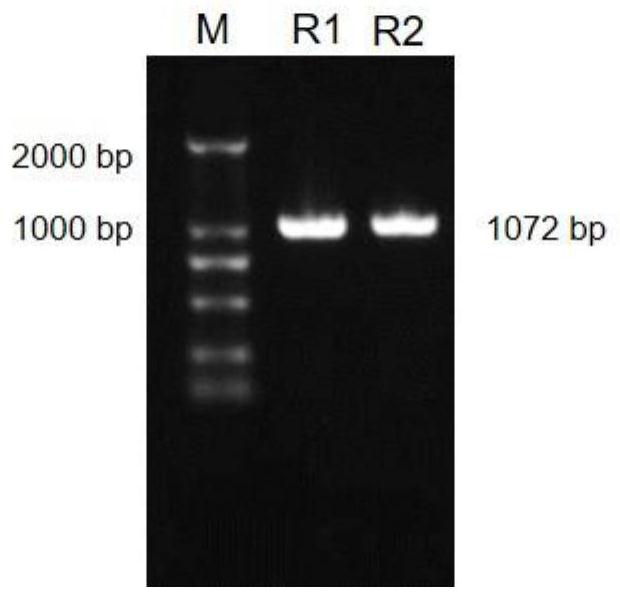Method for improving canker resistance of citrus by utilizing CsNCED3 gene silencing
A technology of gene silencing and canker disease, applied in the field of molecular biology, can solve the problems of nucellus embryo interference, complex genetic background, low efficiency of citrus hybrid breeding, etc., and achieve the effect of improving resistance
- Summary
- Abstract
- Description
- Claims
- Application Information
AI Technical Summary
Problems solved by technology
Method used
Image
Examples
Embodiment 1
[0038] Cloning of CsNCED3 gene fragment
[0039] 1. RNA extraction and cDNA synthesis
[0040] Select 0.1 g of citrus (Wanjincheng) leaves and use the EASYspin Plant RNA Rapid Extraction Kit (Adelaide, CAT: RN09) to extract total RNA from the leaves, verify the quality of RNA by non-denaturing agarose gel electrophoresis, and measure its concentration with a densitometer . cDNA was synthesized using Recombinant DNase I (Bao Biology), and the cDNA was stored at -20°C for future use.
[0041] 2. PCR amplification of CsNCED3 gene fragment
[0042] Using primers RNAi-CsNCED3-F and RNAi-CsNCED3-R to amplify the CsNCED3 fragment from citrus cDNA, the fragment length is 387bp;
[0043] Its nucleotide sequence is as follows, SEQ ID NO.3:
[0044] AATTTTGTGGTGATCCCGGACCAACAAGTCGTTTTCAAGCTCCAAGAAATGATAAC GGGTGGCTCTCCGGTGATTTATGACAAGAACAAGAAGTCCCGGTTCGGGATTCTTGCAA AGAATGCTAAAGATTCTAACGACATCATCTGGATTGAATCACCGGACACGTTCTGCTTTC ACTTGTGGAACGCTTGGGAGGAGCCGGAAACTGATGAAATTGTTGTCATTGGATCATGC ...
Embodiment 2
[0055] Construct CsNCED3 interference expression vector and transform into Agrobacterium
[0056] The vector construction flow chart is as follows figure 1 , among them, GUS::NPTⅡ: fusion gene of β-glucosidase and neomycin phosphotransferase; CaMV 35S: plant constitutive promoter derived from cauliflower mosaic virus; NOS: opine synthase gene termination The vector pLGNe has a GUS::NPTⅡ fusion gene under the control of the CaMV 35S promoter, which is convenient for kanamycin screening and GUS staining identification of transformants during plant genetic transformation; T7 promoter: the plasmid is promoted in Escherichia coli The promoter used for transcription; T7 transcription start: the starting point of T7 promoter to initiate transcription; all restriction endonucleases were purchased from (THERMO) company, and operated according to the instructions.
[0057] Wherein the nucleotide sequence of the CaMV 35S promoter is as follows, SEQ ID NO.4:
[0058] GTCCTCTCCAAATGAAATG...
Embodiment 3
[0064] Genetically Transformed Citrus (Wanjincheng)
[0065] 1. Acquisition of epicotyls from citrus seedlings
[0066] Get fresh citrus (Wan Jincheng) and wash, disinfect the surface with 70% alcohol, take out the seeds under aseptic conditions, peel off the seed coat, inoculate on the seed germination medium to germinate, and culture in dark at 28°C for 2 weeks, then Cultured for 1 week under a 16h light / 8h dark photoperiod. Under aseptic conditions, the epicotyls of germinated seedlings were taken and cut into stem segments of about 1 cm for genetic transformation of Agrobacterium tumefaciens.
[0067] 2. Preparation of Agrobacterium tumefaciens
[0068] The Agrobacterium bacteria solution (containing the CsNCED3 interference expression vector) used for transfection was stored in an ultra-low temperature incubator at -70° C. by adding 30% sterile glycerol. Before transfection, streak culture on LK solid medium containing 50mg / L kanamycin. Pick a single colony of Agrobac...
PUM
 Login to View More
Login to View More Abstract
Description
Claims
Application Information
 Login to View More
Login to View More - R&D
- Intellectual Property
- Life Sciences
- Materials
- Tech Scout
- Unparalleled Data Quality
- Higher Quality Content
- 60% Fewer Hallucinations
Browse by: Latest US Patents, China's latest patents, Technical Efficacy Thesaurus, Application Domain, Technology Topic, Popular Technical Reports.
© 2025 PatSnap. All rights reserved.Legal|Privacy policy|Modern Slavery Act Transparency Statement|Sitemap|About US| Contact US: help@patsnap.com



